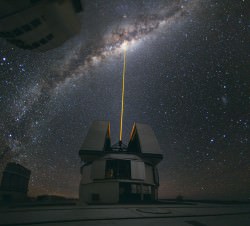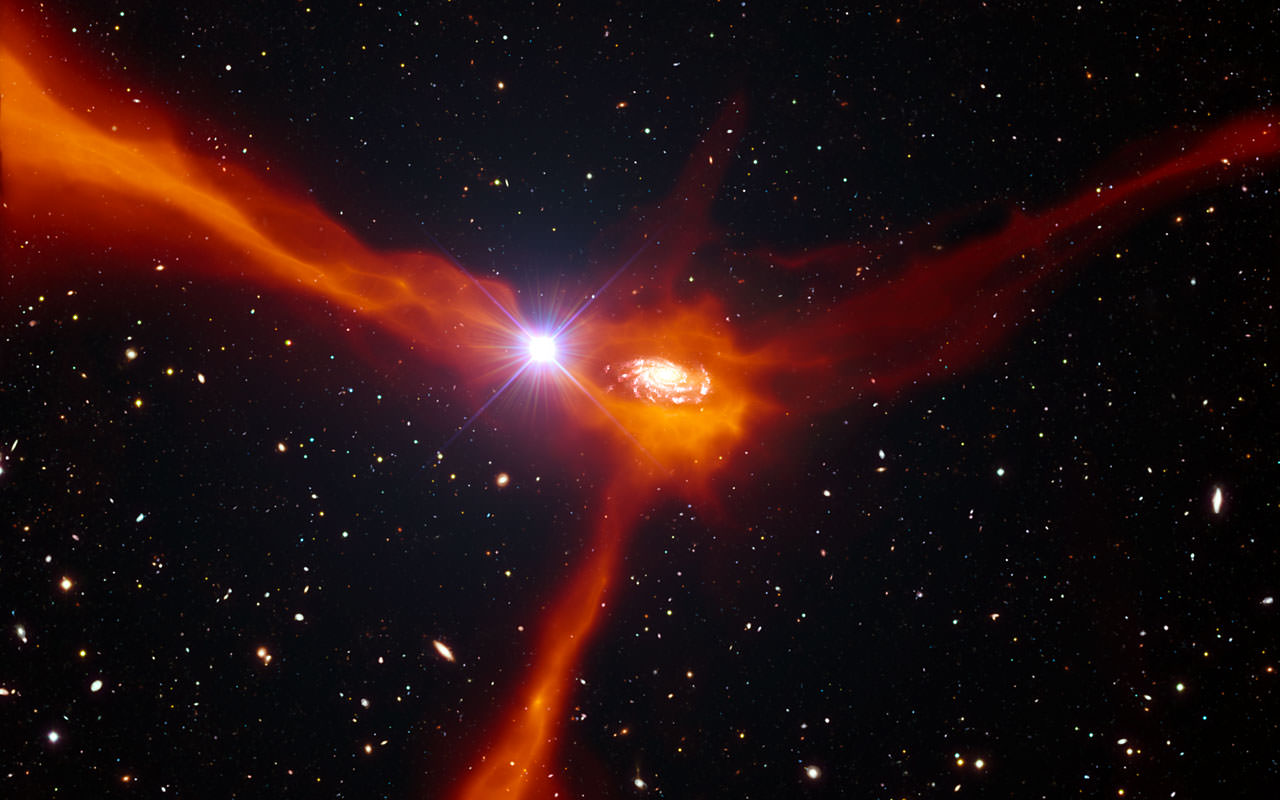If you live in the U.S. you may be enjoying a sultry summer day off in honor of Independence Day, or at least have plans to get together with friends and family at some point to partake in some barbecued goodies and a favorite beverage (or three). And as you saunter around the picnic table scooping up platefuls of potato salad, cole slaw, and deviled eggs, you can also draw a correlation between your own steady accumulation of mayonnaise-marinated mass and a distant hungry galaxy located over 11 billion light-years away.
Astronomers have always suspected that galaxies grow by pulling in material from their surroundings, but this process has proved very difficult to observe directly. Now, ESO’s Very Large Telescope has been used to study a very rare alignment between a distant galaxy and an even more distant quasar — the extremely bright center of a galaxy powered by a supermassive black hole. The light from the quasar passes through the material around the foreground galaxy before reaching Earth, making it possible to explore in detail the properties of the in-falling gas and giving the best view so far of a galaxy in the act of feeding.
“This kind of alignment is very rare and it has allowed us to make unique observations,” said Nicolas Bouché of the Research Institute in Astrophysics and Planetology (IRAP) in Toulouse, France, lead author of the new paper. “We were able to use ESO’s Very Large Telescope to peer at both the galaxy itself and its surrounding gas. This meant we could attack an important problem in galaxy formation: how do galaxies grow and feed star formation?”

Galaxies quickly deplete their reservoirs of gas as they create new stars and so must somehow be continuously replenished with fresh gas to keep going. Astronomers suspected that the answer to this problem lay in the collection of cool gas from the surroundings by the gravitational pull of the galaxy. In this scenario, a galaxy drags gas inwards which then circles around it, rotating with it before falling in.
Although some evidence of such accretion had been observed in galaxies before, the motion of the gas and its other properties had not been fully explored up to now.
Astronomers have already found evidence of material around galaxies in the early Universe, but this is the first time that they have been able to show clearly that the material is moving inwards rather than outwards, and also to determine the composition of this fresh fuel for future generations of stars. And in this particular instance, without the quasar’s light to act as a probe the surrounding gas would be undetectable.
“In this case we were lucky that the quasar happened to be in just the right place for its light to pass through the infalling gas. The next generation of extremely large telescopes will enable studies with multiple sightlines per galaxy and provide a much more complete view,” concluded co-author Crystal Martin of the University of California Santa Barbara.
This research was presented in a paper entitled “Signatures of Cool Gas Fueling a Star-Forming Galaxy at Redshift 2.3”, to appear in the July 5, 2013 issue of the journal Science.
Source: ESO news release


Here’s the (PDF) paper:
Signatures of Cool Gas Fueling a Star-Forming Galaxy at Redshift 2.3.
Artists rendition. Unless it is seen totally in focus, extremely up close and personal. I guess his rendition is suitable. Looks really good. Never seen anything quite like it. Someday maybe 100-200+ years from now all the optics in every spectrum of light, x-rays, and all the “etc’s” will be accumulated into one space-t-scope so we can see any object 3.7 billion light years away like it was Mars. Now that is impressive 😉
Apart from any high energy jets I keep asking myself if any whole galaxy with a central black hole will eventually be totally absorbed by one?
Excellent question. I was under the impression only a ‘star’ can birth black-holes. I’m still stuck with the theory of the chicken and the egg. PUNT?
I just read a paper suggesting that very long time scales (hundreds of billions of years) most stars and gas in such galaxies would either be flung out of orbit or fall into the central SMBH. I am not sure about the dark matter halo, however; without an EM cross section, I don’t see how dark matter particles would shed sufficient energy for their orbits to decay.
The Latinist has sort of the right idea. The N-body interactions between stars and gas will cause some of this material to be ejected. This is similar to evaporative cooling, which means the total energy of the remaining material will decrease. This increases the chance this material will enter into the SMBH.
As for dark matter, since this does not interact by electromagnetic forces there are not many dissipative processes. However, DM particles will in time either be ejected or the remaining ones that remain will have lower total energy. DM particles will then have an increased probability of interacting with the SMBH over time.
Galaxies will in their final state become a huge SMBH with matter that has escaped to “infinity.” This will take some 10^{20} years to be reached. The last stars will wink out 10^{12} year from now, so there will be this large time period where dark galaxies will “evaporate” matter and the remainder will become consumed by the SMBH.
LC